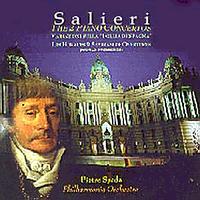Antonio Salieri – Requiem (2005)
Antonio Salieri – Requiem (2005)

1. Introitus - Kyrie 2. Dies Irae 3. Offertorium 4. Domine Jesu Christe 5. Mater Jesu 6. Sanctus Benedictus 7. Agnus Dei 8. Libera me, Domine Philharmonia Orchestra Pietro Spada – conductor
Antonio Salieri composed a Requiem Mass in 1804 for his own obsequies twenty-one years before his death in 1825. Advance preparation of funeral music by a composer for himself is an unusual act. One other composer who did this was Guillaume Dufay, who left instructions in his will for the performance of his Requiem pro defunctis on the day after his funeral. Of course, there are examples of a Requiem commissioned by a patron, which, because of circumstances, took on a personal meaning for the composer.
Here, we think of Mozart and possibly Michael Haydn. As Haydn composed his Requiem for Count Schrattenbach, who died in December, 1771, he surely thought of his only daughter, who had died earlier that year before reaching the age of one.
Salieri's reasons for writing his death mass at this point in his life are unclear. Rudolph Angermuller believes it to be "his way of withdrawing from public life as a composer," citing the end of his operatic work and his turn to church music and more intimate forms. So, did a retirement from the hurly-burly world of opera prompt him to contemplate his own mortality and think about his funeral service? Possibly. At the same time, religious faith may have motivated Salieri to anticipate his departure from the temporal world and to prepare for his entry into the next world. Evidence for this is examined below.
He also may have had in mind the fate of Florian Leopold Gassmann, his mentor and predecessor as Hofkapellmeister. Gassmann died prematurely, like Mozart, leaving his Requiem Mass incomplete. It has been suggested that Gassmann, who had been ill for at least a year before his death, was thinking of it for himself. One can also believe that Joseph Eybler's masterful setting of the Requiem, written in 1803, affected Salieri as well. Eybler, who became Vice-Kapellmeister in June 1804, enjoyed the special patronage of Empress Marie Therese, who commissioned numerous works from him. She requested the Requiem for a commemoration of the death of Emperor Leopold II (d. 1792). Salieri, whose music seemingly did not interest the Empress, probably attended the performance of this work. Eybler's masterwork perhaps inspired him, although the lack of favor by the Empress must have pained him. While Eybler was the more experienced composer of church music, Salieri was, after all, the imperial Kapellmeister.
In this capacity for thirty-six years, Salieri probably directed the liturgy of the Todesmesse numerous times. The court celebrated not only actual funeral Masses, but kept a regular cycle of memorial Seelenmessen, that is, anniversary Requiem Masses commemorating late monarchs, their families, other royal personages and dignitaries, as well as members of knightly orders, such as the Stephansordensritter and Sternkreuzordensdamen. The annual liturgy of Allerseelen on November 2 also called for a Requiem Mass. Between 1820 and 1900, Requiem Masses were performed in the Hofkapelle 641 times.
Although comparable records for most of Salieri's tenure as Hofkapellmeister are not extant, we may be sure that this practice was equally common, if not more so. Court music collections include a great number of Requiem settings by musicians affiliated with the Hofkapelle and also by "outside" composers. Among the former are Georg Reutter (at least four), Giuseppe Bonno (four), and Josef Krottendorfer (one). "Local" non-court composers included Leopold Hoffmann, Joseph Preindl, Johann Hasse, and Christoph Sonnleithner.
The one-year anniversary Seelenmesse for Gluck, whose actual funeral had been conducted in silence, took place in 1788 under Salieri's direction. For this important service, the newly-appointed Kapellmeister chose the Requiem by Niccolo Jommelli, perhaps because it was the most widely performed Requiem setting of the time. Another Requiem produced by Salieri took place during the Congress of Vienna, for which, as Hofkapellmeister, he had charge of the musical activities. ---questia.com
download: uploaded yandex 4shared mediafire solidfiles mega zalivalka filecloudio anonfiles oboom ziddu
Last Updated (Sunday, 27 April 2014 20:16)








